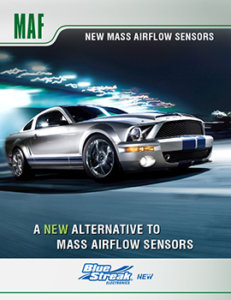MASS AIRFLOW SENSORS
MASS AIRFLOW SENSORS
ABOUT THE NEW LINE
THE CERAMIC ADVANTAGE
ABOUT THE NEW LINE
THE CERAMIC ADVANTAGE

BETTER MATERIAL FOR BETTER RESULTS
Technology moves forward at an ever increasing pace and here at Blue Streak Electronics we always have our eye on the horizon, adopting the latest developments that advance and improve automotive hardware.
Our NEW Mass Airflow Sensor lineup will be incorporating the CERAMIC PCB’s to provide you the very best product with the added enhancements:
- Resistors are digitally calibrated for optimal precision
- Superior thermal stability under even the most extreme under-the-hood temperature changes
- Higher consistency in voltage readings at all rpms
- More efficient heat dissipation to extend the service life of the component
- Double binding for improved sensor reliability
ABOUT THE REMAN LINE
Re-imagining the Reman to make it ORIGINAL
ABOUT THE REMAN LINE
Re-imagining the Reman to make it ORIGINAL
Remanufacturing is the process of taking used parts, completely disassembling and thoroughly cleaning them, replacing the worn components with original quality components, and restoring them to their original function.
The testing and procedures are the same as the original equipment manufacturers.
By fixing and improving components regularly, we know which are the vulnerable parts that need improvement, and can product future demand.
Our 480+ SKUs of OE Reman MAFs give full market coverage.
The line provides OE-quality product to customers who demand it.
We offer quality remanufactured products and knowledgeable professionals ready to assist with any questions you might have.
- Coverage from 1979 to current module year.
- 100% Computerized Testing for all modules and Sensors using advanced test equipment.
- Latest OEM calibrations installed in all programmable modules.
- Common component failures are 100% replaced.
- Complete board reflow to ensure reliable performance.
- Upgraded components used to improve circuit reliability and performance.
- Expert technical support available with every product sold.
- Trilingual installation instructions.
QUALITY ASSURANCE
Pushing Our MAFs to Make the Grade
QUALITY ASSURANCE
Pushing Our MAFs to Make the Grade
Blue Streak Electronics has established the following criteria for evaluation and engineering of the Mass Airflow line. Evaluation is separated into 6 different criteria and any vendor chosen must meet these demands for it to be implemented into our line.
Blue streak Electronics achieved ISO 9001 in 2001 and TS 16949 in 2007. Operating under these standards ensures the highest level of consistent quality for all products leaving our facilities.
FUNCTIONAL TESTING
This is divided into 4 stages of testing, all of which will test the sensor to its fullest. Under ambient air temperature the sensor is tested from minimum to maximum air flow in 10 different points. All other tests are associated with varying degrees of heat being applied to the sensor as well as airstream. This is in attempt to see how the unit will respond under the direst conditions. All of these tests are put through the same varying amount of air across the sensor.
THERMAL TESTING
Thermal testing requires that we heat just the sensor element at a constant airflow rate varying the amount of heat being applied and calculating any changes in the output. We increment our heat from room temperature to the maximum allowed by the OE manufacturer.
THERMAL STRESS
Thermal stress requires that heat the element to maximum temperature and put the sensor into ambient airstream. We then measure the time it takes for the sensor to come back within specification.
POWER SUPPLY
We examine the ability of the airflow sensor to respond to different voltages and its ability to provide a stable signal.
POWER CONSUMPTION
The amount of current the sensor is using is measured and compared to the manufacturer’s specification.
SIGNAL STABILITY and VIBRATION
Under low airstream, the sensor is subjected to extreme vibration and 30 measurements are taken. The sensor has to fully perform under these conditions.
SEGMENTS
SEGMENTS
-
Our SKU's
We have 450 Reman MAF SKU’s and 50 revamped New MAF SKU programs:
-
Vane Meter Sesnor (VAF Sensor)
The VAF (volume air flow) sensor measures the air flow into the engine with a spring-loaded air flap/door attached to a variable resistor (potentiometer). The vane moves in proportion to the airflow. A voltage is applied to the potentiometer and a proportional voltage appears on the output terminal of the potentiometer in proportion to the distance the vane moves, or the movement of the vane may directly regulate the amount of fuel injected, as in the K-Jetronic system.
Many VAF sensors have an air-fuel adjustment screw, which opens or closes a small air passage on the side of the VAF sensor. This screw controls the air-fuel mixture by letting a metered amount of air flow past the air flap, thereby, leaning or richening the mixture. By turning the screw clockwise the mixture is enriched and counterclockwise the mixture is leaned.
The vane moves because of the drag force of the air flow against it; it does not measure volume or mass directly. The drag force depends on air density (air density in turn depends on air temperature), air velocity and the shape of the vane, see drag equation. Some VAF sensors include an additional intake air temperature sensor (IAT sensor) to allow the engines ECU to calculate the density of the air, and the fuel delivery accordingly.
The vane meter approach has some drawbacks:
-
Hot Wire Sensor
A hot wire mass airflow sensor determines the mass of air flowing into the engine’s air intake system. The theory of operation of the hot wire mass airflow sensor is similar to that of the hot wire anemometer (which determines air velocity). This is achieved by heating a wire suspended in the engine’s air stream, like a toaster wire, with either a constant voltageover the wire or a constant current through the wire. The wire’s electrical resistance increases as the wire’s temperature increases, which varies the electrical current flowing through, or the voltage over the circuit, according to Ohm’s law. When air flows past the wire, the wire cools, decreasing its resistance, which in turn allows more current to flow through the circuit or causing a smaller voltage drop over the wire. As more current flows, the wire’s temperature increases until the resistance reaches equilibrium again. The current or voltage drop is proportional to the mass of air flowing past the wire. The integrated electronic circuit converts the measurement into a calibrated signal which is sent to the ECU.
If air density increases due to pressure increase or temperature drop, but the air volume remains constant, the denser air will remove more heat from the wire indicating a higher mass airflow. Unlike the vane meter’s paddle sensing element, the hot wire responds directly to air density. This sensor’s capabilities are well suited to support the gasoline combustion process which fundamentally responds to air mass, not air volume. (See stoichiometry.)
This sensor sometimes employs a mixture screw, but this screw is fully electronic and uses a variable resistor (potentiometer) instead of an air bypass screw. The screw needs more turns to achieve the desired results. A hot wire burn-off cleaning circuit is employed on some of these sensors. A burn-off relay applies a high current through the platinum hot wire after the vehicle is turned off for a second or so, thereby burning or vaporizing any contaminants that have stuck to the platinum hot wire element.
The hot film MAF sensor works somewhat similar to the hot wire MAF sensor, but instead it usually outputs a frequency signal. This sensor uses a hot film-grid instead of a hot wire. It is commonly found in late 80’s early 90’s fuel-injected vehicles. The output frequency is directly proportional to the air mass entering the engine. So as mass flow increases so does frequency. These sensors tend to cause intermittent problems due to internal electrical failures. The use of an oscilloscope is strongly recommended to check the output frequency of these sensors. Frequency distortion is also common when the sensor starts to fail. Many technicians in the field use a tap test with very conclusive results. Not all HFM systems output a frequency. In some cases, this sensor works by outputting a regular varying voltage signal.
Some of the benefits of a hot-wire MAF compared to the older style vane meter are:
There are some drawbacks:
-
Cold Wire Sensor
The GM LS engine series (as well as others) use a coldwire MAF system (produced by AC Delco) that works similarly to the hot-wire MAF system however, it uses an additional “cold” resistor to measure the ambient air and provide a reference for the “hot” resistor element used to measure the air flow. [1]
The mesh on the MAF is used to smooth out airflow to ensure the sensors have the best chance of a steady reading. It is not used for measuring the air flow per se. In situations where owners use oiled-gauze air filters, it is possible for excess oil to coat the MAF sensor and skew its readings. Indeed, General Motors has issued a Technical Service Bulletin, indicating problems from rough idle all the way to possible transmission damage resulting from the contaminated sensors. To clean the delicate MAF sensor components, a specific MAF sensor cleaner or electronics cleaner should be used, not carburetor or brake cleaners, which can be too aggressive chemically. Instead, the liquid phase of MAF sensor cleaners and electronics cleaners is typically based on hexanes or heptanes with little to no alcohol content and use either carbon dioxide or HFC-152a as aerosol propellants. The sensors should be gently sprayed from a careful distance to avoid physically damaging them and then allowed to thoroughly dry before reinstalling. Manufacturers claim that a simple but extremely reliable test to ensure correct functionality is to tap the unit with the back of a screwdriver while the car is running, and if this causes any changes in the output frequency then the unit should be discarded and an OEM replacement installed.
-
Kármán Vortex Sensor
A Kármán vortex sensor works by disrupting the air stream with a perpendicular bow. Providing that the incoming flow is laminar, the wakeconsists of an oscillatory pattern of Kármán vortices. The frequency of the resulting pattern is proportional to the air velocity.
These vortices can either be read directly as a pressure pulse against a sensor, or they can be made to collide with a mirror which will then interrupt or transmit a reflected light beam to generate the pulses in response to the vortices. The first type can only be used in pull-thru air (prior to a turbo- or supercharger), while the second type could theoretically be used push- or pull-thru air (before or after a forced induction application like the previously mentioned super- or turbocharger). Instead of outputting a constant voltage modified by a resistance factor, this type of MAF outputs a frequency which must then be interpreted by the ECU. This type of MAF can be found on all DSMs (Mitsubishi Eclipse, Eagle Talon, Plymouth Laser), many Mitsubishis, some Toyotas and Lexus, and some BMWs, among others.[2]
-
Membrane Sensor
An emerging technology utilizes a very thin electronic membrane placed in the air stream. The membrane has a thin film temperature sensor printed on the upstream side, and one on the downstream side. A heater is integrated in the center of the membrane which maintains a constant temperature similar to the hot-wire approach. Without any airflow, the temperature profile across the membrane is uniform. When air flows across the membrane, the upstream side cools differently from the downstream side. The difference between the upstream and downstream temperature indicates the mass airflow.
The thermal membrane sensor is also capable of measuring flow in both directions, which sometimes occur in pulsating situations. Technological progress allows this kind of sensor to be manufactured on the microscopic scale as microsensors usingmicroelectromechanical systems technology. Such a microsensor reaches a significantly higher speed and sensitivity compared with macroscopic approaches. See also MEMS sensor generations.





